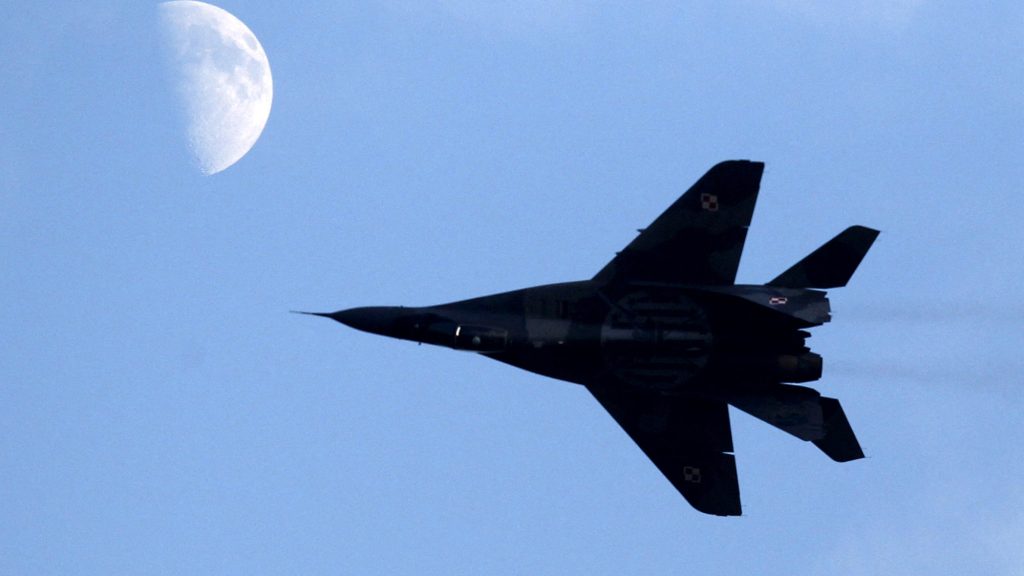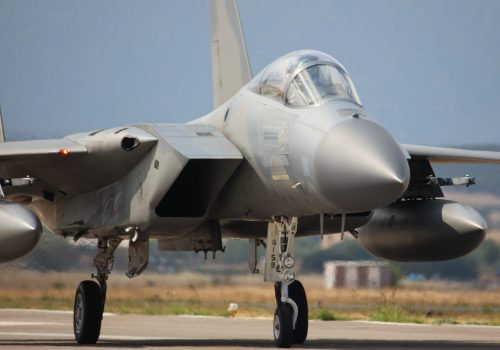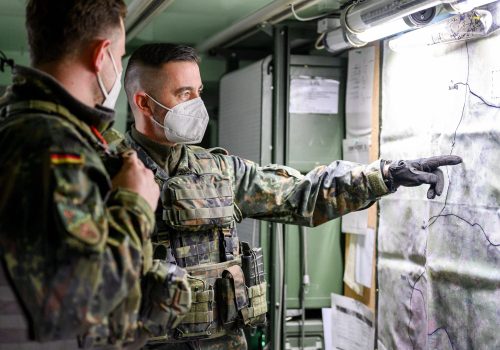As Russia’s military campaign in Ukraine grinds away, decimating cities and claiming more civilian lives each day, Western policymakers are grasping for ways to stop the killing. One of the major debates from Washington to Kyiv is whether the United States and NATO should impose a no-fly zone over Ukraine. In this series, Atlantic Council experts grapple with both sides of the controversial question, as well as offer other ways the West can help if, as seems likely at the moment, implementing a no-fly zone isn’t feasible. Below, Kelly Grieco argues against a no-fly zone. Read Richard D. Hooker, Jr.’s case in favor of a no-fly zone and Sarah Dawn Petrin and Marla Keenan’s proposal for other humanitarian interventions.
“Air power is an unusually seductive form of military strength, in part because, like modern courtship, it appears to offer gratification without commitment,” the political scientist Eliot Cohen warned in 1994. Yet three decades—and endless wars and foreign interventions—later, many foreign-policy experts and lawmakers remain enamored with US air weaponry. With Russian troops using increasingly brutal tactics in Ukraine, causing so much death and destruction, some have called on the Biden administration and NATO to impose a no-fly zone (NFZ) over all or part of the nation under attack. Air power appears to them to be a panacea—a relatively low-cost and low-risk option to support the Ukrainian military and alleviate the humanitarian tragedy. It’s an alluring prospect.
However, it is also a dangerous oversimplification. Implementing an NFZ over even just the western part of Ukraine or for the protection of humanitarian corridors would deliver the ultimate trifecta of bad outcomes: It would be a costly and difficult mission; it would lead to direct military confrontation with Russia; and it would all be for naught. Indeed, it would only prolong the loss of life and human suffering without changing the ultimate outcome of the war.
Costly and difficult
The NFZ idea came of age in the unipolar moment, when the United States possessed such an overwhelming advantage in air power that it made quick work of ruling enemy skies. The United States and NATO countries set up NFZs, banning enemy aircraft from flying in designated airspace, to protect friendly forces and civilians in Iraq after the 1991 Gulf War; in Bosnia-Herzegovina during the Balkans war from 1993-95, and in Libya during its civil war in 2011. Those cases pitted American and allied air forces against weak opponents with older aircraft and inadequate air defenses that were no match for NATO’s combination of stealth and precision-guided munitions.
An NFZ makes uncontested air supremacy the goal. As US Air Force combat veterans Mike Pietrucha and Mike Benitez explain, “Air supremacy means not only control of the air, but also the elimination of threats to air operations from the ground.” Given the ease with which US and NATO air forces have dominated enemy skies over the past three decades, such preeminance can almost seem like a “birthright.”
However, Vladimir Putin’s Russia is not Saddam Hussein’s Iraq; the Russian military has the advanced surface-to-air missiles, man-portable air defense systems, and anti-aircraft artillery to contest any NFZ. The United States and NATO cannot reasonably expect to gain and maintain air supremacy over Ukraine. Without it, an NFZ is not operationally feasible.
Instead, US and NATO aircraft would confront, in the words of General Mark Kelly, the commander of Air Combat Command, “layer upon layer upon layer” of Russian S-300 and S-400 interceptors. It would require a large-scale campaign to suppress/destroy enemy air defenses, leaning heavily on US fifth-generation aircraft, such as the F-22 Raptor and F-35 Lightning II. These aircraft would be engaged in a “cat-and-mouse” game with Russia’s surface-to-air missile systems, which are mobile, making them hard to find and destroy.
In the Gulf War, US and coalition forces hunted Iraq’s truck-mounted Scud missiles, but they failed to achieve a single confirmed kill. A few years later, in Kosovo, NATO failed to gain air superiority against the dispersed and mobile air-defense systems of the Serbian-led rump Yugoslav state. At a NATO defense ministers’ meeting held after that war, a European defense official offered that the most fundamental lesson of the war was that “we never want to do this again.” No one laughed in response.
The airspace over Ukraine would be even more heavily contested than in Kosovo or Iraq. Russian air defenses would kill or capture some US and NATO pilots. The mission would also require an immense investment of resources and would involve continuous combat air patrols, supported by command and control, intelligence, surveillance, and reconnaissance assets; aerial refueling planes; search-and-rescue helicopters; and maintenance and logistics. To enforce NFZs over Iraq between 1991 and 2003, American and coalition forces flew an average of 34,000 sorties per year, or the equivalent of fighting the Gulf War every three years. The enforcement of a no-fly zone is not war lite. It is war.
Inherent danger
That is also why an NFZ is so breathtakingly dangerous, with the potential to raise the risks of nuclear war. An NFZ needs to be enforced by military means, putting US and NATO pilots in the position of shooting down Russian aircraft and killing some of their personnel, both in the air and on the ground. There is another problem: Russia’s long-range air defenses reach well into Ukraine from Russia and Belarus, so effective enforcement of a full or even partial NFZ would almost certainly require bombing Russian territory.
Calling it a “limited” or “humanitarian” NFZ in no way limits the risks. It still amounts to a declaration of war against Russia. A “humanitarian” NFZ may “not seek direct confrontation with Russian forces,” but Putin would hold all the escalatory cards in this scenario.
There is no reason to expect him to back down. After years of deepening distrust and mutual suspicion, both NATO and Russia tend to view each other’s actions in the worst possible light, which raises the dangers of inadvertent escalation. “If the Russians hear that Western leaders are thinking of an NFZ,” a European official explained to the Washington Post, Putin’s “mind goes back to Libya in 2011, where NATO intervenes, and months later [Moammar] Gaddafi is pulled out of a hole and killed.”
For Putin, the stakes over a NATO NFZ are likely existential. He issued thinly veiled nuclear threats at the start of the war and also warned that Russia would view “any move in this direction” as an intervention that would make NATO countries “participants in the military conflict.” Perhaps Putin is bluffing, but it is irresponsible to run the risk.
Poor track record
Even if the US and NATO were prepared to accept enormous costs and risks, it’s important to remember that past NFZs have an unimpressive record in protecting civilians. As one study concluded, “The ways and means available are insufficient to accomplish the desired ends. Due to the risk of civilian casualties, environmental factors, and the inherent limitations of airpower, no-fly zones are not capable of protecting civilians.”
And a “limited” NFZ might actually end up making the unfolding humanitarian catastrophe worse. It offers nothing but a false sense of security, encouraging Ukrainian civilians to seek refuge in “humanitarian corridors” or “safe havens,” where it would not be able to adequately protect them from the ground war. Russia’s brutal tactics come from firepower delivered by ground forces and multi-launch rocket-artillery systems, cruise missiles, ballistic missiles, and conventional artillery—not air power. An NFZ would not target these systems and therefore offers little additional protection to civilians or the Ukrainian military. It would probably lead to calls for a “no-drive zone” in which US and NATO aircraft attack Russian ground forces. Mission creep would be a real danger. The longer the war lasts, the more the Ukrainian people will suffer.
What is the alternative?
Russia’s criminal invasion of Ukraine is a terrible tragedy. However, the Biden administration and NATO leaders must avoid the temptation to “do something” that might make Western publics feel better but would not actually help the Ukrainian people. US and NATO support to Ukraine has helped the country to resist so far, and it should continue. But Washington and its allies must be honest about the limits of that support and avoid a direct confrontation with Russia. Instead, they must continue to provide—where safely possible—weapons, ammunition, and equipment to Ukraine’s military, and food and humanitarian relief for the country’s civilian population.
Intervening beyond that would only make the nightmare worse.
Kelly A. Grieco is a resident senior fellow with the New American Engagement Initiative in the Atlantic Council’s Scowcroft Center for Strategy and Security.
Further reading
Fri, Mar 18, 2022
A no-fly zone over Ukraine? The case for NATO helping in other ways.
New Atlanticist By
There’s plenty NATO member states can do to protect civilians on the ground short of shooting down Russian aircraft.
Fri, Mar 18, 2022
A no-fly zone over Ukraine? The case for NATO doing it.
New Atlanticist By Richard D. Hooker, Jr.
The West stands at the crossroads. It's time to act by establishing a no-fly zone over Ukraine.
Mon, Mar 7, 2022
A new era for NATO has begun
New Atlanticist By
On a political and on a military level, NATO is closer than ever—and readier than ever.
Image: Polish Air Force MiG-29 pilot Adrian Rojek performs during the Radom Air Show at an airport in Radom, Poland on August 23, 2015. Photo via REUTERS/Kacper Pempel.



